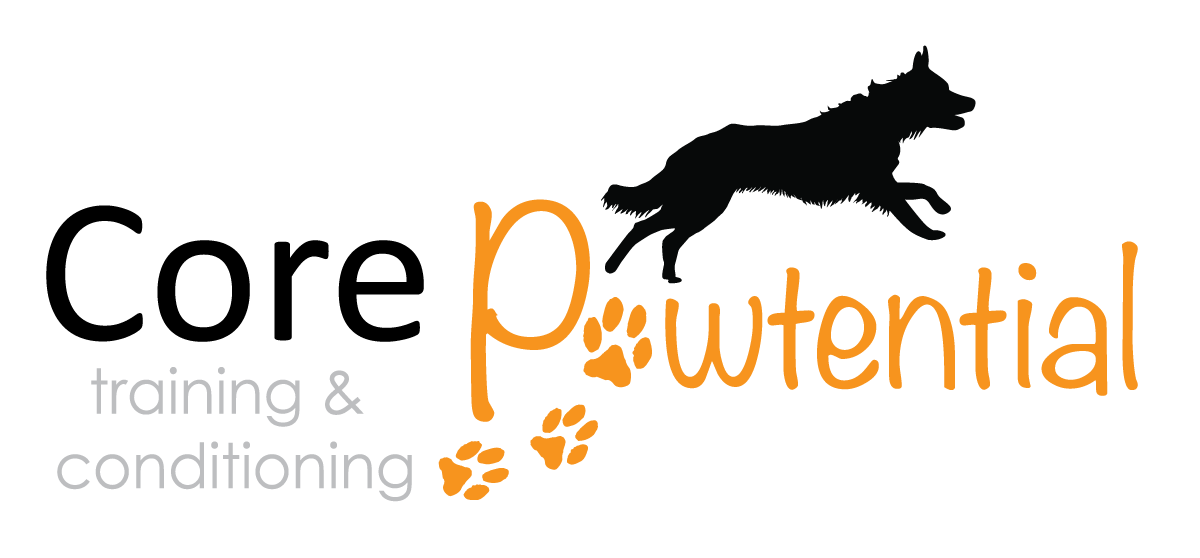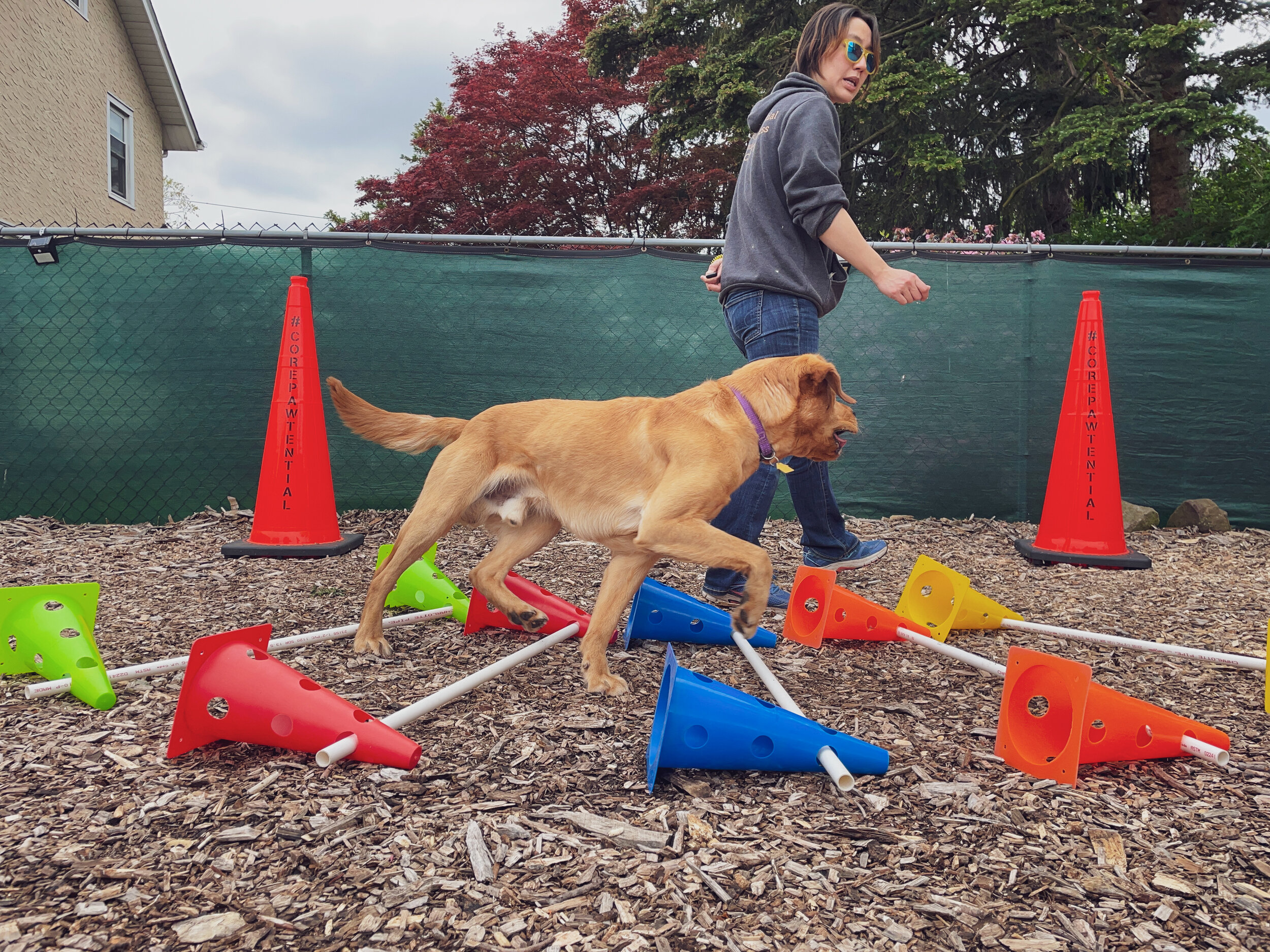
Cavaletti FAQs
How to make your own set of cavaletti
A cavaletti set consists of a number of poles, and a pair of blocks for each pole to raise the pole off the ground.
Cavaletti poles:
You can use PVC pipes, wooden dowels, jump bars, broom sticks, or even golf clubs! I have mine cut at about 3 feet wide. I like mine light so they are easy to move and store.
Cavaletti blocks:
Cavaletti blocks are the objects you use to raise the two ends of the poles off the ground. One of my favorite options is traffic cones with hole pre-drilled into them; I purchased them online. Although there are cheaper options with bigger holes available, I found them to be too light and flimsy to my liking. Other options are to use cinder blocks, soda cans (make a dent in the middle), bricks, or PVC connectors.
What do you mean by withers height?
Withers height refers to the distance from the highest point of the shoulder blade to the ground.
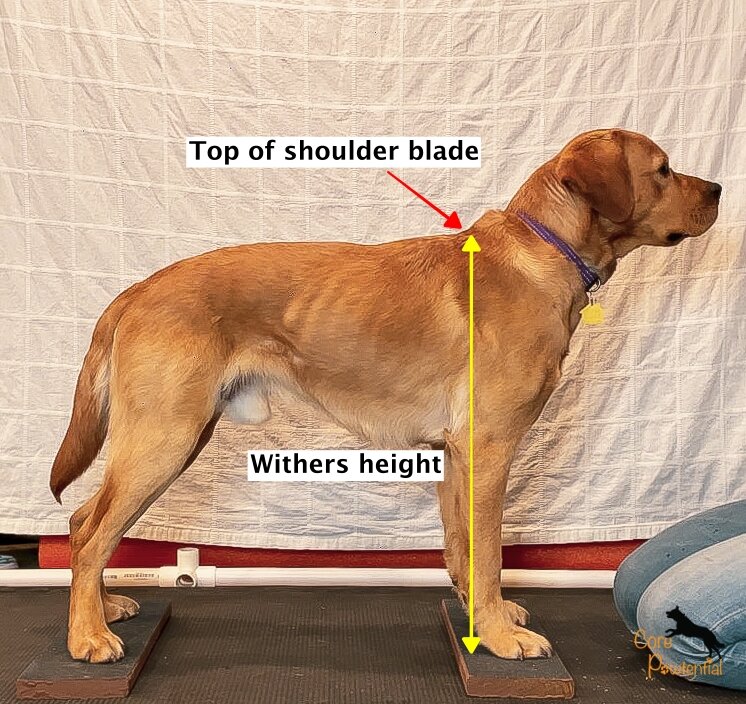
What do you mean by elbow height?
Elbow height refers to the distance from the elbow joint to the ground.
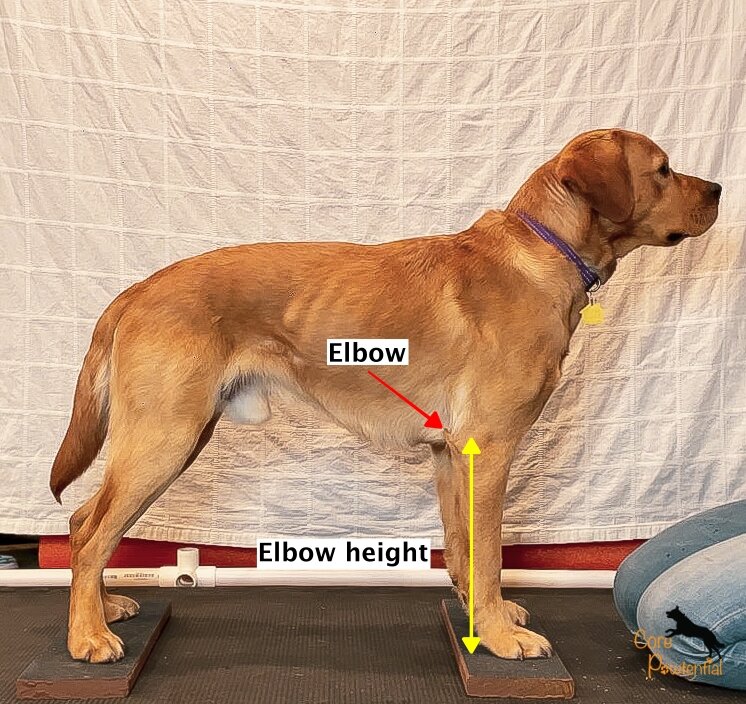
What do you mean by hock height?
Hock height is the distance from the top of the hock joint to the ground.
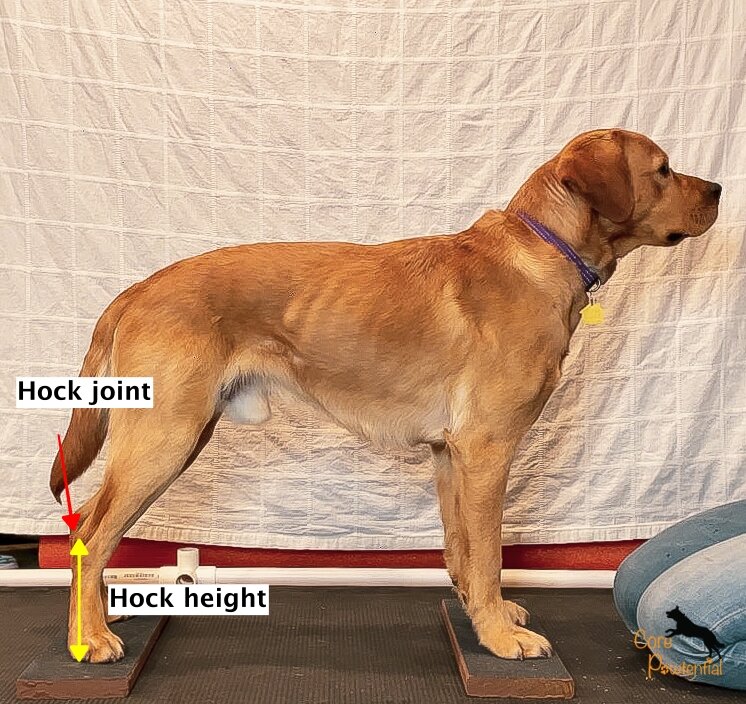
Why should we keep the poles no higher than hock height?
The presence of the cavaletti poles is to help the dog to be more mindful about picking up each foot as they move across the setup. As the goal of cavaletti is to encourage the dog to trot through the poles, setting the poles at lower than hock height will allow them to move through the setup with correct form. When the poles are set higher than hock height, the setting will be more likely to encourage the dog to hop or skip over the poles due to the increased height. As a result, the dog would be less likely to be able to trot through the poles, but rather hopping, skipping or jumping over the poles, which is not the goal of the straight line cavaletti.
Similarly, long back dogs (e.g., corgis, dashunds, basset hounds) and small dogs may never need to raise the poles off the ground in order to keep the poles lower than hock height.
What is a trot?
A trot is a 2-beat gait where a dog moves their diagnoal front and rear legs (left front + right rear; right front + left rear) forward and land on the ground at the same time. After a diagonal pair od legs lift off, there is a short moment of suspension before the other diagonal pair lands on the ground. This is typically considered the most efficient gait for dogs.
Click here for an animation demonstrating different types of canine gaits.
What is a rep?
A "rep" refers to a repetition. For straight line and curved cavaletti setups, one repetition (1 rep) refers to when a dog trots across the cavaletti setup once.
What is a set?
A set is the number of repetitions (i.e., reps) a dog completes before taking a break. For example, 1 set of 5 reps means that the dog trots across a cavaletti setup 5 times before taking a break.
How to increase the number of reps?
The reasonable number of reps to aim for depends on your dog’s age, physical condition, experience, and other factors (e.g., weather, the amount of distraction). The numbers I list here are meant to be for reference only, not to be used as a rule of thumb.
With healthy adult dogs with no pre-existing conditions, I usually start with 4-6 reps a session until I am reasonably confident that they are comfortable with the exercise (i.e., confidently trotting across the cavaletti setup, focus forward, feet land approximately mid-point between two poles). Then, I usually aim for 1 set of 10 reps of a beginner/intermediate level exercise before progressing.
With puppies, the goal is to introduce them to cavaletti and keep the exercise fun. I will keep the number of reps low, approximately 4-6 reps per session.
With senior dogs and/or dogs with pre-existing conditions, I usually allow them more time to get comfortable with the setup. Depending on the dog, I may aim for 6-8 reps of a beginner level exercise before progressing the next level. For dogs who are particularly struggling (e.g., dogs with neurological conditions), I may aim for 2 reps of a beginner level exercise to start, and slowly increase to 4 -5 reps in the next few seessions.
How to increase the number of sets?
I typically reduce the number of reps when increasing the number of sets to help my dogs succeed. For example, a dog can comfortably complete 1 set of 10 reps. My next goal is to increase to 2 sets of 10 reps = a total of 20 reps. Take for example, a dog who can complete 1 set of 10 reps. To increase the number of reps, I may ask for
- 2 sets of 6 reps (a total of 12 reps), or
- 2 sets of 8 reps (a total of 16 reps).
However, If the dog finds this to be too difficult, I may ask for
- 3 sets of 4 reps (a total of 12 reps), or
- 3 sets of 5 reps (a total of 15 reps) instead.
I will not ask for 2 sets 10 reps (a total of 20 reps) until the dog can complete less than or equal to 20 reps in any rep/set combination.
How many reps/sets should I do for each exercise?
Like all conditioning and fitness exercises, the number of reps/sets depends on your dog's age, fitness level, conditioning goal, and environmental condition. For puppies, the goal of the exercise is to teach them about body awareness, so I would keep the number of reps low (e.g., 5 reps), and keep the session short and fun. For healthy seniors, the goal of the exercise is to help keep them mobile. Depending on their fitness level, I might try to do 1 set of 10 reps in the beginning, aiming to 2 sets of 10 reps, or 4 sets of 5 reps per session. For healthy canine atheletes, the number of reps/sets will also differ depending on their fitness level and the overall conditioning goal.
Keep in mind that the environmental condition may also play a role in the number of reps/sets per session. For example, I would keep the number of reps/sets low in a highly stimulating environment and/or on a particularly hot day. I would also keep the number of reps low for dogs who are new to cavaletti exercise.
The rule of thumb is to do the number of reps/sets appropriate for your dog's age and fitness level, and watch for signs of fatigue during each session. When in doubt, don't hesitate to seek advice from certified canine fitness professionals!
More importantly, dogs that are injured and/or sick, and/or recovering from injury and/or sickness should seek the advice of veterinarin professionals before starting any exercise program.
How often should I do cavaletti exercise with my dog?
The frequency of cavaletti exercise depends on your dog's age, fitness level, and conditioning goal. In general, I try to incorporate 2-3 sessions (< 5 minute per session) of cavaletti exercise a week for my healthy adult dogs when the weather is nice. Healthy adult dogs will often make significant progress even if you incorporate 1 session (< 5 minute) of cavaletti exericse per week.
Nonetheless, it is important to keep in mind that dogs that are injured and/or sick, and/or recovering from injury and/or sickness should seek the advice of veterinarin professionals before starting any exercise program.
Can I do these cavaletti exercises with my puppy?
Provided that your puppy is healthy with no known sickness and/or injury, yes! However, remember to keep the height of the poles low for safety. At this point, the goal of the cavaletti is to teach puppies about body awareness so remember to keep the number of reps low per session.
My dog is recovering from injury/surgery, can I do these cavaletti exericses?
As I am not a veterinarin professional, I cannot speak to whether or not cavaletti exericse is appropriate for your dog. You should seek advice from your veteranian and/or rehabilitation and/or physical therapy professionals prior to starting any exercise program.
Can I do these exercises with my dog on the leash?
For the straight line and curved cavaletti (Modules 1 and 2), yes. However, I would recommend keep the leash loose enough so that the dog can trot at his own pace, but not so loose that his legs may get tangled on the leash.
For other cavaletti setups, I would recommend the dog be off leash.
Can my dog wear a harness when doing the cavaletti?
I generally recommend the dog not wear a harness for cavaletti, however, I also understand that some dogs may need a harness for safety purposes. If your dog must wear a harness, please make sure the harness is
- well-fitted, and
- non-restrictive - typically Y-shaped.
The leash, if using, should be attached to the back clip of the harness.
What kind of surface do you recommend for cavaletti exercise?
I typcially do cavaletti exercise on relatively flat, non-slippery surface. If outdoors, I would recommend avoiding hard, abrasive surfaces, such as concrete, cement, asphalt, and/or rocky surfaces. If indoors, I would recommend adding non-slippery surfaces for the floor, such as rubber mats, yoga mats, carpets/rugs that do not slide, and/or other anti-slippery materials. I do not recommend puzzle foam mats for flooring as they are usually slippery for dogs' feet.
What can I use for "anchor" objects? Do they have to be identical?
You can use any two target-type things that your dog is "attracted" to. You can use two platforms, flat targets, bath mats, or raised beds. They do not need to be identical, as long as your dog does not have a strong preference for one over the other.
The purpose of using anchor objects is to provide a visual cue for the dog to drive towards, especially for dogs who are too young and/or have not learned to wrap a cone.
Should I use "anchor" objects or bowls for my dog?
There is no definitive answer, as it depends on your individual dog.
I have found that using "anchor" objects have worked well especially for dogs who move fast and tend to rush through the cavaletti poles. The "anchor" objects seem to give them a clear visual cue to focus on, and a clearly defined space to put their feet.
For dogs who may need a little more encouragement to go through the poles and/or focus forward, the use of a bowl at both ends of the cavaletti setup give them something to focus on (and look forward to).
It may be helpful to experiment with the setup in different sessions (i.e., use anchors in one session, use bowls for another) to see which method works best for your dog at the time.
Can I use a remote treat dispenser instead of the bowl at the end of the setup?
Absolutely! I don't use one only because I don't have one. :)
Why do you sometimes raise the bowls off the floor?
I would raise the bowl off the floor to encourage forward focus. For larger-sized dogs, they may develop a tendency to dive down towards the bowl as they clear the last cavaletti pole, putting additional strain to their shoulders. By raising the bowl off the floor, I can help them drive forward rather than downward.
How far away should the anchor objects/bowls/cones?
Because I have limited space, I typically set the anchor objects/bowls/cones at least one stride length from the last pole. That is, I would like the dog to be able to take two more steps after their front foot clear the last pole. If there is more space available, I would set the anchor objects two stride lengths from the last pole to allow the dog ample room to move. Nonetheless, you may have to adjust the distance depending on the indiviual dog.
If the anchor objects are set too close to the last pole, some dogs may be forced to stop sooner than they intend to, and they may end up taking a shorter stride for the last pole. Other dogs may try to get to the anchor sooner, and they may end up over extending themselves for the last pole and/or after clearing the last pole.
If the anchor objects are set too far away from the last pole, some dogs may speed up when approaching the cavaletti poles, and they may not be able to go through the cavaletti setup in a trot.
Why isn't cone wrap (i.e., go around the cone) a pre-requisite skill for cavaletti?
Although I tend to use cone wraps for more eperienced dogs as a way to increase the number of repetitions, I consider the cone wrap a skill separate from cavaletti that requires practice. Most importantly, I would like the cone wrap itself to be controlled. The dog should be able to move around the cone in a controlled manner, with each leg taking independent steps. Many dogs, especially fast dogs, tend to go around the cone too fast, and end up "flinging" their rear end around the cone using the momentum from their front, rather than follow through with a lateral (i.e., side) flexion of their body. Until a dog is able to execute a cone wrap in a controlled manner, I would not include it as part of the cavaletti workout.
Second, many dogs who do not know cone wraps (e.g., puppies, foster dogs, senior dogs, special-needs dogs) CAN benefit from cavaletti exercise! I think it is perfectly fine for dogs to work on their cavaletti skills regardless of whether or not they can go around a cone. In these cases, I make use of the "anchor" objects and/or bowls to help the dog focus forward.
How many cavaletti poles should I start with?
There are no rule of thumb for this answer. For puppies, I usually start shaping with one pole, then quickly progress to two or three poles in the next few sessions. For adult dogs, I typically start with 3-5 poles to get them familiar with the cavaletti setup.
Some dogs may be more likely to jump over the poles if there are only one or two poles setup, whereas others may be intimated if there are too many poles. I have found that 3-4 poles is usually a good place to start, and depending on your dog's initial reaction, you can quickly remove or add more poles.
Should I use even or odd number cavaletti poles?
Although many people recommend even number of poles to work both sides (left and right) equally, I have not been able to find any scientific evidence to support this. Since most dogs do not necessarily lead with one leg (i.e., always cross the first pole with the left or right front leg), there is no reason to assume that an even number of poles is paricularly more beneficial than an odd number of poles.
On the other hand, if you notice that your dog consistently adjust their stride so that one leg is always the lead when approaching the straight line cavaletti, it may indicate a potential underlying issue and I would strongly recommend seeking professional medical advice.
When I increase the number of poles, how many poles should I increase at a time?
I usually increase the number of poles by adding one to each end of the original setup, meaning that if I was working with 5 poles, I would increase it to 7 poles. However, if the dog seems to be consistently struggling with 7 poles, I will drop down to 6 poles.
